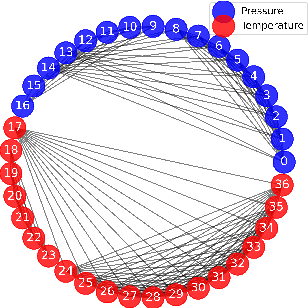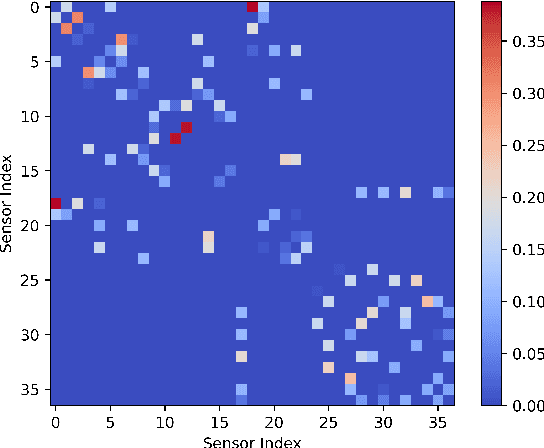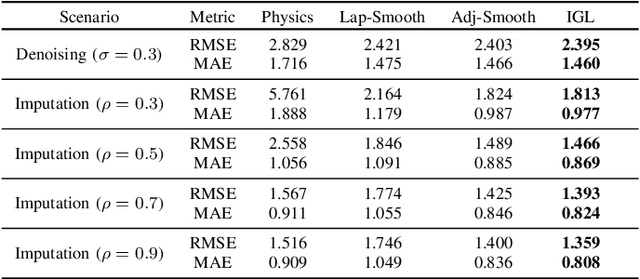Gaëtan Frusque
Informed Graph Learning By Domain Knowledge Injection and Smooth Graph Signal Representation
Jun 06, 2024


Abstract:Graph signal processing represents an important advancement in the field of data analysis, extending conventional signal processing methodologies to complex networks and thereby facilitating the exploration of informative patterns and structures across various domains. However, acquiring the underlying graphs for specific applications remains a challenging task. While graph inference based on smooth graph signal representation has become one of the state-of-the-art methods, these approaches usually overlook the unique properties of networks, which are generally derived from domain-specific knowledge. Overlooking this information could make the approaches less interpretable and less effective overall. In this study, we propose a new graph inference method that leverages available domain knowledge. The proposed methodology is evaluated on the task of denoising and imputing missing sensor data, utilizing graph signal reconstruction techniques. The results demonstrate that incorporating domain knowledge into the graph inference process can improve graph signal reconstruction in district heating networks. Our code is available at \href{https://github.com/Keiv4n/IGL}{github.com/Keiv4n/IGL}.
Semi-Supervised Health Index Monitoring with Feature Generation and Fusion
Dec 05, 2023



Abstract:The Health Index (HI) is crucial for evaluating system health, aiding tasks like anomaly detection and predicting remaining useful life for systems demanding high safety and reliability. Tight monitoring is crucial for achieving high precision at a lower cost, with applications such as spray coating. Obtaining HI labels in real-world applications is often cost-prohibitive, requiring continuous, precise health measurements. Therefore, it is more convenient to leverage run-to failure datasets that may provide potential indications of machine wear condition, making it necessary to apply semi-supervised tools for HI construction. In this study, we adapt the Deep Semi-supervised Anomaly Detection (DeepSAD) method for HI construction. We use the DeepSAD embedding as a condition indicators to address interpretability challenges and sensitivity to system-specific factors. Then, we introduce a diversity loss to enrich condition indicators. We employ an alternating projection algorithm with isotonic constraints to transform the DeepSAD embedding into a normalized HI with an increasing trend. Validation on the PHME 2010 milling dataset, a recognized benchmark with ground truth HIs demonstrates meaningful HIs estimations. Our methodology is then applied to monitor wear states of thermal spray coatings using high-frequency voltage. Our contributions create opportunities for more accessible and reliable HI estimation, particularly in cases where obtaining ground truth HI labels is unfeasible.
NNG-Mix: Improving Semi-supervised Anomaly Detection with Pseudo-anomaly Generation
Nov 20, 2023Abstract:Anomaly detection (AD) is essential in identifying rare and often critical events in complex systems, finding applications in fields such as network intrusion detection, financial fraud detection, and fault detection in infrastructure and industrial systems. While AD is typically treated as an unsupervised learning task due to the high cost of label annotation, it is more practical to assume access to a small set of labeled anomaly samples from domain experts, as is the case for semi-supervised anomaly detection. Semi-supervised and supervised approaches can leverage such labeled data, resulting in improved performance. In this paper, rather than proposing a new semi-supervised or supervised approach for AD, we introduce a novel algorithm for generating additional pseudo-anomalies on the basis of the limited labeled anomalies and a large volume of unlabeled data. This serves as an augmentation to facilitate the detection of new anomalies. Our proposed algorithm, named Nearest Neighbor Gaussian Mixup (NNG-Mix), efficiently integrates information from both labeled and unlabeled data to generate pseudo-anomalies. We compare the performance of this novel algorithm with commonly applied augmentation techniques, such as Mixup and Cutout. We evaluate NNG-Mix by training various existing semi-supervised and supervised anomaly detection algorithms on the original training data along with the generated pseudo-anomalies. Through extensive experiments on 57 benchmark datasets in ADBench, reflecting different data types, we demonstrate that NNG-Mix outperforms other data augmentation methods. It yields significant performance improvements compared to the baselines trained exclusively on the original training data. Notably, NNG-Mix yields up to 16.4%, 8.8%, and 8.0% improvements on Classical, CV, and NLP datasets in ADBench. Our source code will be available at https://github.com/donghao51/NNG-Mix.
Smart filter aided domain adversarial neural network: An unsupervised domain adaptation method for fault diagnosis in noisy industrial scenarios
Jul 04, 2023



Abstract:The application of unsupervised domain adaptation (UDA)-based fault diagnosis methods has shown significant efficacy in industrial settings, facilitating the transfer of operational experience and fault signatures between different operating conditions, different units of a fleet or between simulated and real data. However, in real industrial scenarios, unknown levels and types of noise can amplify the difficulty of domain alignment, thus severely affecting the diagnostic performance of deep learning models. To address this issue, we propose an UDA method called Smart Filter-Aided Domain Adversarial Neural Network (SFDANN) for fault diagnosis in noisy industrial scenarios. The proposed methodology comprises two steps. In the first step, we develop a smart filter that dynamically enforces similarity between the source and target domain data in the time-frequency domain. This is achieved by combining a learnable wavelet packet transform network (LWPT) and a traditional wavelet packet transform module. In the second step, we input the data reconstructed by the smart filter into a domain adversarial neural network (DANN). To learn domain-invariant and discriminative features, the learnable modules of SFDANN are trained in a unified manner with three objectives: time-frequency feature proximity, domain alignment, and fault classification. We validate the effectiveness of the proposed SFDANN method based on two fault diagnosis cases: one involving fault diagnosis of bearings in noisy environments and another involving fault diagnosis of slab tracks in a train-track-bridge coupling vibration system, where the transfer task involves transferring from numerical simulations to field measurements. Results show that compared to other representative state of the art UDA methods, SFDANN exhibits superior performance and remarkable stability.
Non-contact Sensing for Anomaly Detection in Wind Turbine Blades: A focus-SVDD with Complex-Valued Auto-Encoder Approach
Jun 19, 2023Abstract:The occurrence of manufacturing defects in wind turbine blade (WTB) production can result in significant increases in operation and maintenance costs and lead to severe and disastrous consequences. Therefore, inspection during the manufacturing process is crucial to ensure consistent fabrication of composite materials. Non-contact sensing techniques, such as Frequency Modulated Continuous Wave (FMCW) radar, are becoming increasingly popular as they offer a full view of these complex structures during curing. In this paper, we enhance the quality assurance of manufacturing utilizing FMCW radar as a non-destructive sensing modality. Additionally, a novel anomaly detection pipeline is developed that offers the following advantages: (1) We use the analytic representation of the Intermediate Frequency signal of the FMCW radar as a feature to disentangle material-specific and round-trip delay information from the received wave. (2) We propose a novel anomaly detection methodology called focus Support Vector Data Description (focus-SVDD). This methodology involves defining the limit boundaries of the dataset after removing healthy data features, thereby focusing on the attributes of anomalies. (3) The proposed method employs a complex-valued autoencoder to remove healthy features and we introduces a new activation function called Exponential Amplitude Decay (EAD). EAD takes advantage of the Rayleigh distribution, which characterizes an instantaneous amplitude signal. The effectiveness of the proposed method is demonstrated through its application to collected data, where it shows superior performance compared to other state-of-the-art unsupervised anomaly detection methods. This method is expected to make a significant contribution not only to structural health monitoring but also to the field of deep complex-valued data processing and SVDD application.
Slab Track Condition Monitoring Based on Learned Sparse Features from Acoustic and Acceleration Signals
May 11, 2022



Abstract:The implementation of concrete slab track solutions has been recently increasing particularly for high-speed lines. While it is typically associated with low periodic maintenance, there is a significant need to detect the state of slab tracks in an efficient way. Data-driven detection methods are promising. However, collecting large amounts of labeled data is particularly challenging since abnormal states are rare for such safety-critical infrastructure. To imitate different healthy and unhealthy states of slab tracks, this study uses three types of slab track supporting conditions in a railway test line. Acceleration sensors (contact) and acoustic sensors (contactless), are installed next to the three types of slab track to collect the acceleration and acoustic signals as a train passes by with different speeds. We use a deep learning framework based on the recently proposed Denoising Sparse Wavelet Network (DeSpaWN) to automatically learn meaningful and sparse representations of raw high-frequency signals. A comparative study is conducted among the feature learning / extraction methods, and between acceleration signals and acoustic signals, by evaluating the detection effectiveness using a multi-class support vector machine. It is found that the classification accuracy using acceleration signals can reach almost 100%, irrespective which feature learning / extraction method is adopted. Due to the more severe noise interference in acoustic signals, the performance of using acoustic signals is worse than of using acceleration signals. However, it can be significantly improved by leaning meaningful features with DeSpaWN.
 Add to Chrome
Add to Chrome Add to Firefox
Add to Firefox Add to Edge
Add to Edge